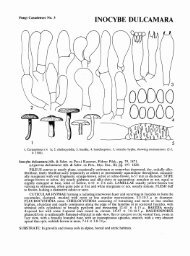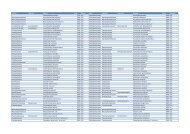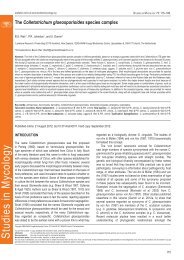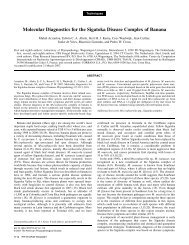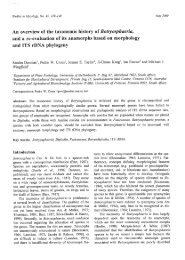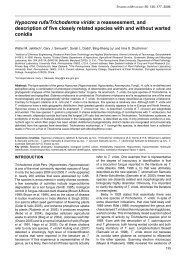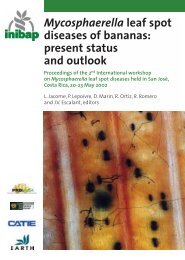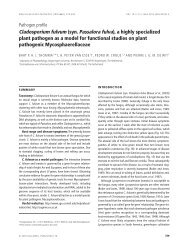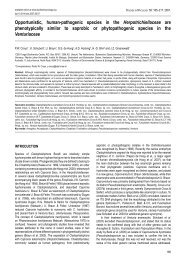Acremonium phylogenetic overview and revision of ... - CBS - KNAW
Acremonium phylogenetic overview and revision of ... - CBS - KNAW
Acremonium phylogenetic overview and revision of ... - CBS - KNAW
Create successful ePaper yourself
Turn your PDF publications into a flip-book with our unique Google optimized e-Paper software.
above for A. sclerotigenum <strong>and</strong> may represent a relatively common<br />
situation in acremonioid species. As another example Gams (1971)<br />
lists “Gliomastix murorum var. felina pro parte in Dickinson in Mycol<br />
Pap. 115: 16, 1968” as an additional synonym <strong>of</strong> this taxon.<br />
As mentioned above in the discussion <strong>of</strong> the genus, Kiyuna<br />
et al. (2010) recently neotypified Gliomastix felina (basionym<br />
Periconia felina Marchal, Bull. Soc. R. Bot. Belg. 34:141. 1895) with<br />
<strong>CBS</strong> 147.81, an isolate collected by Hammill (1981). This isolate<br />
is a typical G. roseogrisea, a taxon not studied by Kiyuna et al.<br />
(2010).<br />
5. Gliomastix tumulicola (Kiyuna, An, Kigawa & Sugiy.)<br />
Summerbell, comb. nov. MycoBank MB519599.<br />
Basionym: <strong>Acremonium</strong> tumulicola Kiyuna, An, Kigawa & Sugiy.,<br />
Mycoscience 52: 13. 2010.<br />
This newly described species is <strong>phylogenetic</strong>ally placed by its<br />
original authors (Kiyuna et al. 2010) in the Gliomastix clade <strong>and</strong><br />
comparison <strong>of</strong> sequences confirms that placement. Although this<br />
information was received too late to include this species in our<br />
<strong>phylogenetic</strong> analyses, the species is placed in Gliomastix.<br />
Sarocladium<br />
The genus Sarocladium was described for two pinkish coloured<br />
fungal pathogens causing sheath blast <strong>of</strong> rice (Gams & Hawksworth<br />
1976). The drawings in that paper <strong>and</strong> the photographs in Bills et<br />
al. (2004) show structures that overlap with those produced by the<br />
<strong>phylogenetic</strong>ally related A. kiliense, A. strictum, <strong>and</strong> A. zeae. As in<br />
Fusarium, plant pathogenic fungi that sporulate on above-ground<br />
plant parts are likely to produce upright, branching sporulating<br />
structures with mucoid conidia suggesting dispersal by insects<br />
that fly from plant to plant. Species with habitats where water<br />
flux or microarthropod movement may be important in dispersal,<br />
e.g., various Acremonia occurring in soil or Fusarium domesticum<br />
growing on cheese, may have simplified conidiogenous structures.<br />
Bills et al. (2004) suggested that the generic placement <strong>of</strong><br />
<strong>Acremonium</strong> kiliense <strong>and</strong> A. strictum should be re-examined in light<br />
<strong>of</strong> their close relationship with Sarocladium oryzae.<br />
The genus Sarocladium is delineated here to include several<br />
species previously recognised in <strong>Acremonium</strong>, as seen in Figs 1 <strong>and</strong><br />
2. In Fig. 2, where <strong>phylogenetic</strong> signal is relatively low, Sarocladium<br />
tepidly (84 % bootstrap) links to the A. bacillisporum clade. In Fig. 1, it<br />
links with a 99 % bootstrap value. Phylogenetic clustering algorithms<br />
<strong>of</strong>ten insert the A. bacillisporum clade between A. strictum <strong>and</strong> A.<br />
kiliense due to certain apo- or plesiomorphies shared with one or the<br />
other <strong>of</strong> these two members <strong>of</strong> the A. strictum clade (data not shown).<br />
On the other h<strong>and</strong>, the next most closely related clade in Fig. 1, the<br />
A. breve/A. curvulum clade, has ITS sequences with substantial<br />
sections that are difficult to align with those <strong>of</strong> the A. bacillisporum<br />
<strong>and</strong> A. strictum clades, indicating considerable evolutionary distance.<br />
The genus Sarocladium is emended here to include those<br />
species that belong to the A. strictum <strong>and</strong> A. bacillisporum clades.<br />
The generic name Sagrahamala is not a contender for this group<br />
because the type species is the unrelated <strong>Acremonium</strong> luzulae. In<br />
addition <strong>Acremonium</strong> luzulae is a species in need <strong>of</strong> epitypification,<br />
because, as shown in the present study, more than one <strong>phylogenetic</strong><br />
species is encompassed under the name.<br />
Sarocladium W. Gams & D. Hawksw., Kavaka 3: 57. 1976<br />
[1975].<br />
www.studiesinmycology.org<br />
acremonium phylogeny<br />
Colonies on 2 % malt extract agar slimy-glabrous to moderately<br />
floccose to deeply dusty, sometimes ropy; with, in Gams’<br />
terminology (Gams 1971), phalacrogenous, nematogenous, to<br />
plectonematogenous conidiation; growing 13–25 mm in 10 d at<br />
20 °C, whitish to pinkish to salmonaceous or, when conidia are<br />
formed in chains, sometimes acquiring vivid conidial mass colouration<br />
such as ochraceous or greenish glaucous; reverse pale to pinkish<br />
orange to pale grey-brown, rarely greenish-blue. Conidiogenous<br />
apparatus ranging from adelophialides, solitary orthotropic phialides<br />
to conidiophore structures with one or a few branches, or with<br />
cymose branching or occasionally with one or two ranks <strong>of</strong> loosely<br />
structured verticils, sometimes with repeated branching extending to<br />
90 μm long. Phialides subulate, aculeate to acerose, straight, slightly<br />
curved, or undulate, thin- <strong>and</strong> smooth-walled, 15–60(–75) μm long,<br />
tapering from a basal width <strong>of</strong> 1.2–2.5 μm, with minimal collarette;<br />
conidia borne in mucoid heads or dry chains, notably longer than<br />
broad, l/w mostly 2.2–7.0, cylindrical to fusiform to bacilliform,<br />
aseptate, smooth-walled, with rounded or tapered-truncate ends,<br />
3.5–8(–14) × 0.5–2 μm. Chlamydospores present or absent, when<br />
present relatively thick-walled, smooth or slightly roughened, globose<br />
to ellipsoidal, intercalary or terminal, mostly solitary, occasionally in<br />
short chains, 4–8 μm. Internal transcribed spacer sequence mostly<br />
with distinctive CGGTCGCGCC motif in mid-ITS2 region.<br />
Several species <strong>of</strong> Sarocladium are noted for melanogenesis<br />
yielding ochre-brown to dark grey-brown colony reverse colours on<br />
Sabouraud agar: S. glaucum, S. kiliense, <strong>and</strong> S. zeae (Gams 1971).<br />
In the case <strong>of</strong> S. kiliense, this melanogenesis has the result that<br />
most mycetoma cases feature black "grains" or sclerotium-like balls<br />
<strong>of</strong> compacted fungal hyphae (Summerbell 2003); melanogenesis<br />
is a well known pathogenicity factor in fungal diseases <strong>of</strong> humans<br />
<strong>and</strong> animals (Gómez & Nosanchuk 2003). As recognised here<br />
Sarocladium yields a remarkable unity <strong>of</strong> species with elongated<br />
conidia <strong>and</strong> phialides. Several species including S. kiliense, S.<br />
oryzae, <strong>and</strong> S. strictum form adelophialides prominently, at least in<br />
some isolates; acremonioid species outside Sarocladium usually<br />
lack this character.<br />
The recognised species are given below. <strong>Acremonium</strong><br />
implicatum may belong here, but the species lacks living ex-type or<br />
representative material. The “A. implicatum” isolate that grouped in<br />
Sarocladium, <strong>CBS</strong> 243.59, is noted by Gams (1971) as an authentic<br />
isolate <strong>of</strong> Fusidium terricola J.H. Mill., Giddens & A.A. Foster <strong>and</strong><br />
this name could be used if A. implicatum sensu Gams is revealed<br />
as polyphyletic. The other “A. implicatum” isolate, <strong>CBS</strong> 397.70B,<br />
included in this study is not a Sarocladium; rather it is a member <strong>of</strong><br />
the A. exiguum clade.<br />
1. Type species. Sarocladium oryzae (Sawada) W. Gams &<br />
D. Hawksw., Kavaka 3: 58. 1976 [1975].<br />
A description <strong>and</strong> synonymy are given by Gams & Hawksworth<br />
(1975). Bills et al. (2004) synonymised Sarocladium attenuatum with<br />
S. oryzae based on the reported identity <strong>of</strong> the ITS sequence <strong>of</strong> its<br />
ex-type isolate, <strong>CBS</strong> 399.73, with that <strong>of</strong> representative isolates <strong>of</strong> S.<br />
oryzae. We resequenced the ITS region <strong>of</strong> <strong>CBS</strong> 399.73 <strong>and</strong> obtained<br />
a sequence differing from Bills et al. (AY566995) by 6 base-pairs<br />
<strong>and</strong> 2 gaps. Some <strong>of</strong> the base pairs in our sequence appeared to<br />
be symplesiomorphies shared with A. kiliense or A. strictum but not<br />
S. oryzae, rather than r<strong>and</strong>om mutations or possible miscalls. Our<br />
resequencing <strong>of</strong> unequivocal S. oryzae isolates <strong>CBS</strong> 180.74 <strong>and</strong><br />
<strong>CBS</strong> 361.75 yielded results consistent with those <strong>of</strong> Bills et al. (2004).<br />
The status <strong>of</strong> S. attenuatum thus requires further study.<br />
157




